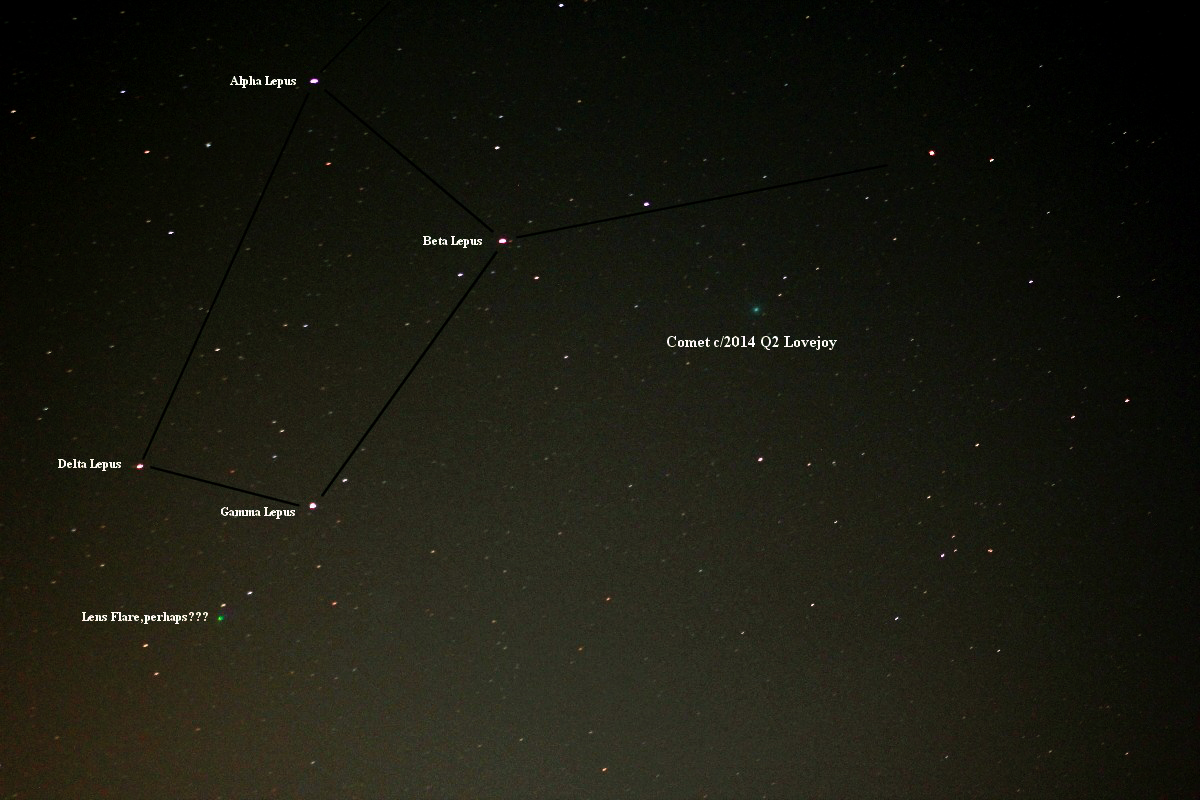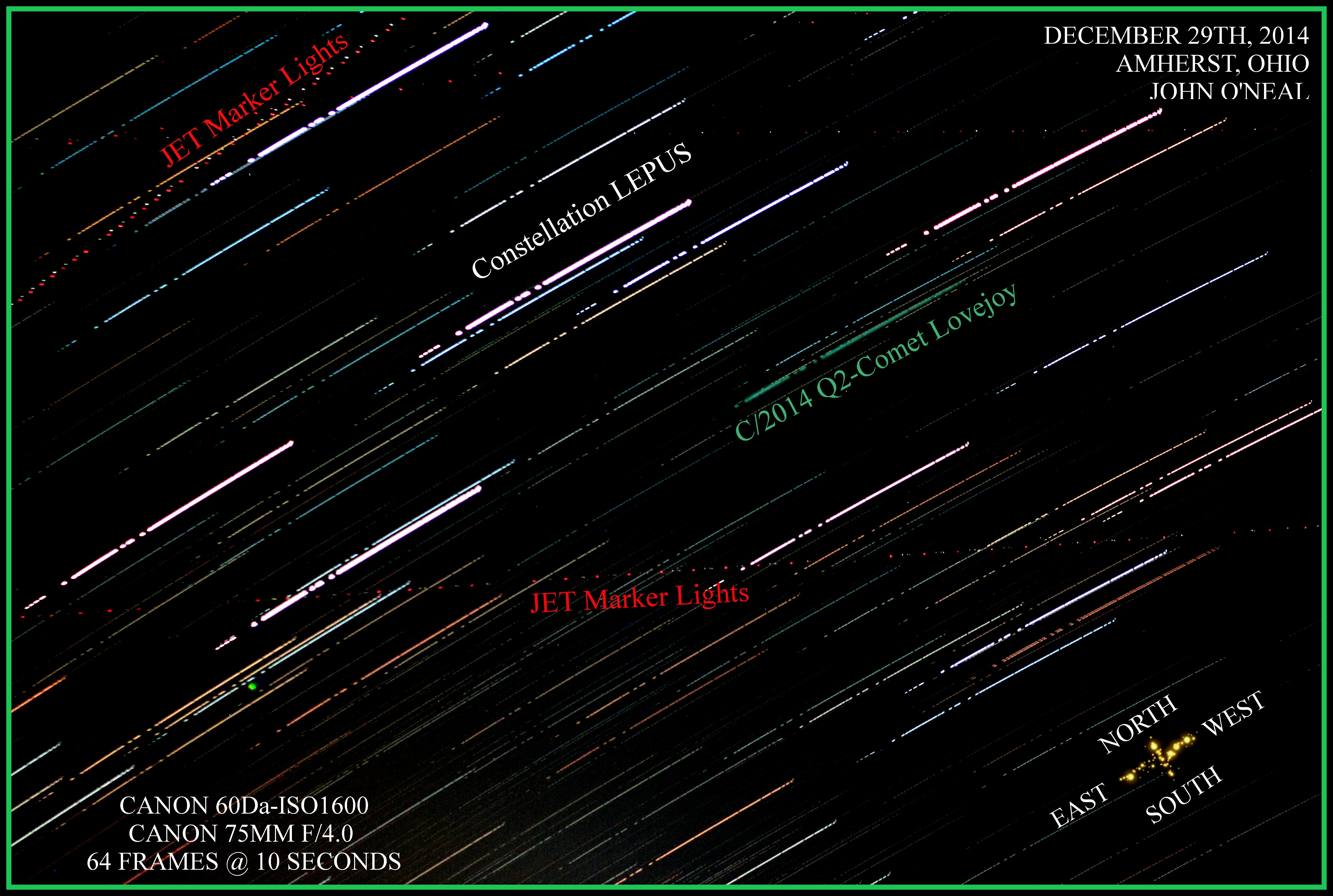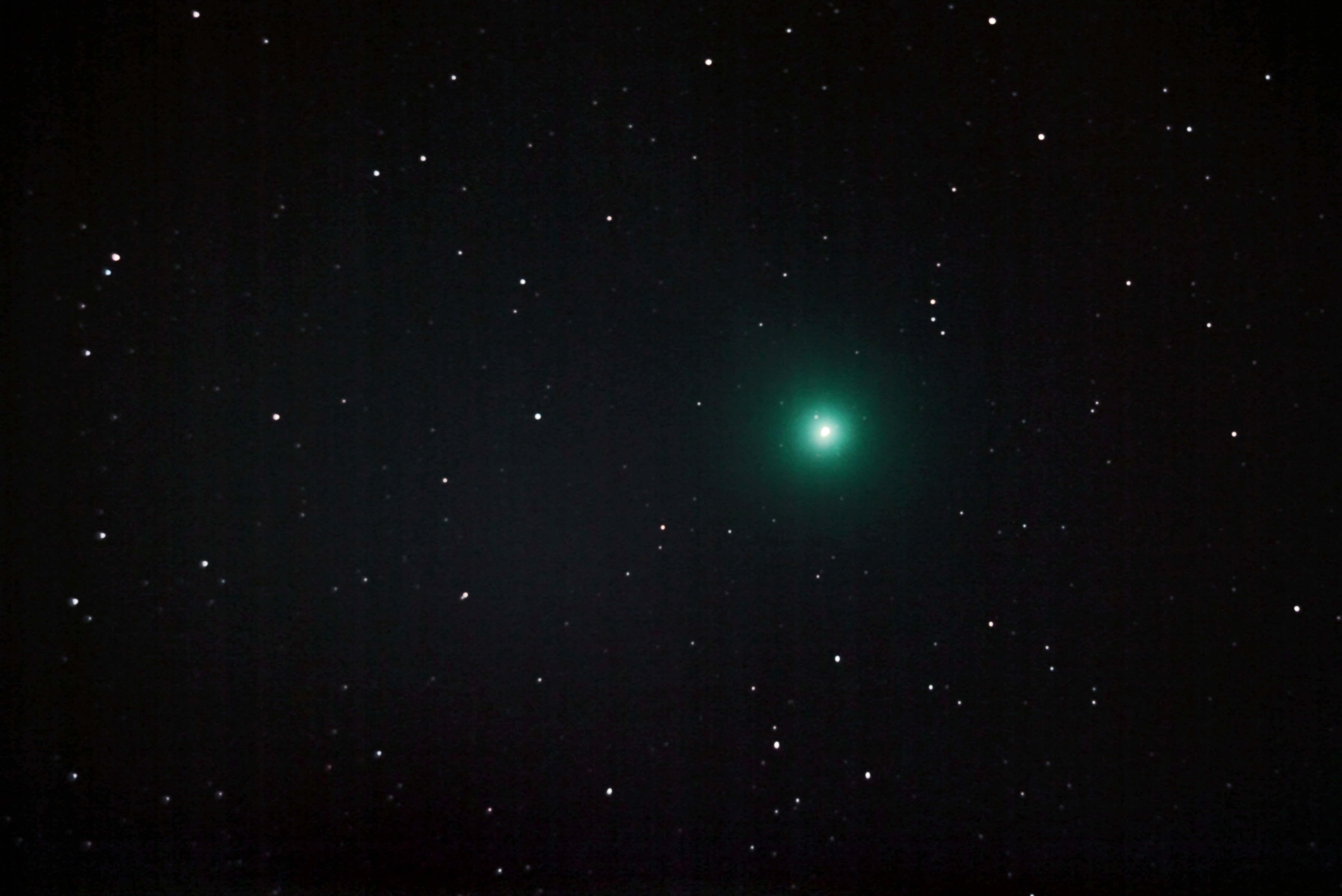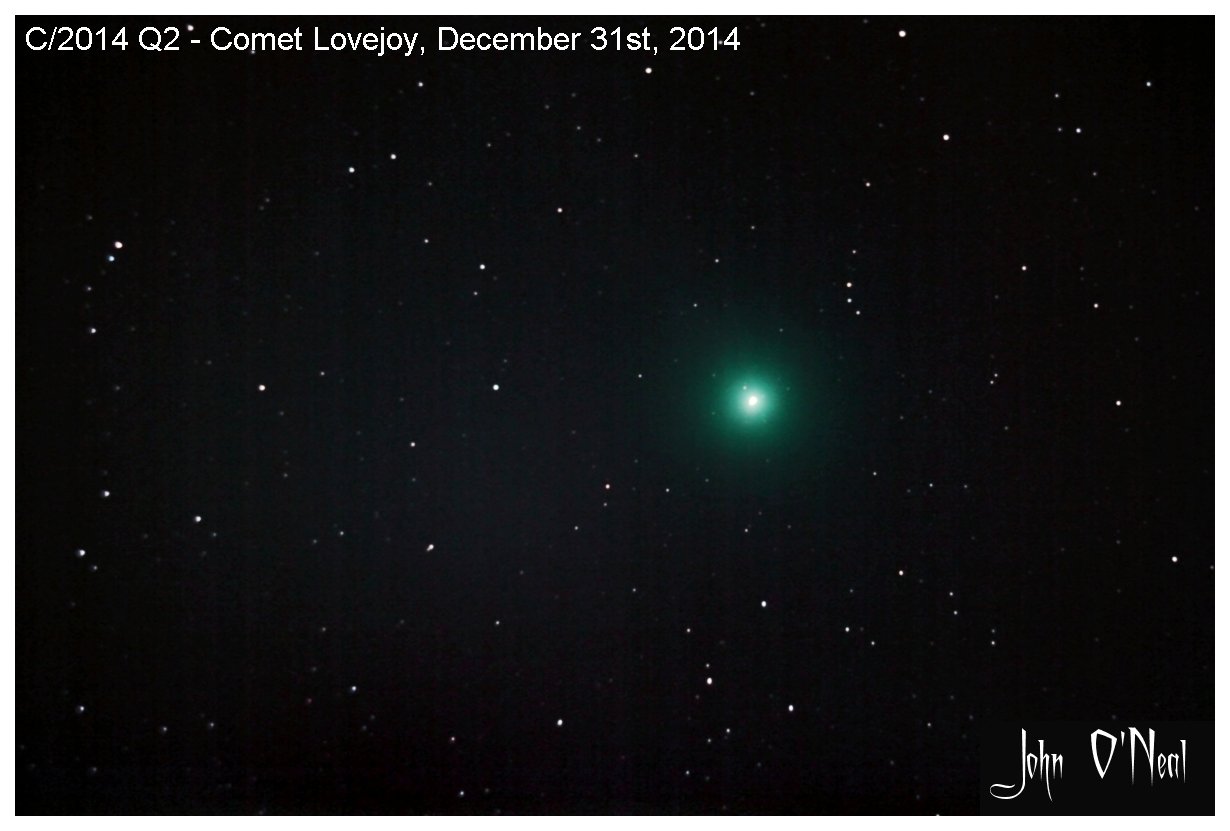C/2014 Q2 Comet Lovejoy
is a long period comet discovered on August 17th, 2014 by Terry Lovejoy
using a 0.2 meter (8 inch) Schmidt-Cassegrain telescope.
It was discovered at an apparent 15th magnitude in the southern constellation of Puppis. It is the fifth comet discovered by Lovejoy.
It's blue green glow is the result of organic molecules and water released by the comet fluorescing under the intense UV and opticl light of the sun as it passes through space.
By December 2014, the comet had brightened to roughly magnitude 7.4, making it a small telescope and binoculars target.
By mid-December, the comet was visible to the naked eye for experienced observers with dark skies and keen eyesight.
On 28−29 December 2014, the comet passed 1/3° from globular cluster Messier 79.
In January 2015, it brightened to roughly magnitude 4, and became one of the brightest comets located high in a dark sky since comet C/1995 O1 (Hale-Bopp) in 1997.
On 7 January 2015, the comet passed 0.469 AU (70,200,000 km; 43,600,000 mi) from Earth.
It crossed the celestial equator on 9 January 2015, becoming better seen from the Northern Hemisphere.
The comet came to perihelion (closest approach to the Sun) on 30 January 2015, at a distance of 1.29 AU (120,000,000 mi) from the Sun.
At perihelion, its water production rate exceeded 20 metric tons per second.
C/2014 Q2 originated from the Oort cloud, but is not a dynamically new comet.
Before entering the planetary region (epoch 1950), C/2014 Q2 had an orbital period of about 11,000 years, with an aphelion about 995 AU from the Sun.
After leaving the planetary region (epoch 2050), it will have an orbital period of about 8,000 years, with aphelion of about 800 AU.
The comet was observed to release 21 different organic molecules in gas, including ethanol and glycolaldehyde, a simple sugar.
The presence of organic molecules suggests that they are preserved materials synthesized in the outskirts of the solar nebula or at earlier stages of the Solar System formation.
It was discovered at an apparent 15th magnitude in the southern constellation of Puppis. It is the fifth comet discovered by Lovejoy.
It's blue green glow is the result of organic molecules and water released by the comet fluorescing under the intense UV and opticl light of the sun as it passes through space.
By December 2014, the comet had brightened to roughly magnitude 7.4, making it a small telescope and binoculars target.
By mid-December, the comet was visible to the naked eye for experienced observers with dark skies and keen eyesight.
On 28−29 December 2014, the comet passed 1/3° from globular cluster Messier 79.
In January 2015, it brightened to roughly magnitude 4, and became one of the brightest comets located high in a dark sky since comet C/1995 O1 (Hale-Bopp) in 1997.
On 7 January 2015, the comet passed 0.469 AU (70,200,000 km; 43,600,000 mi) from Earth.
It crossed the celestial equator on 9 January 2015, becoming better seen from the Northern Hemisphere.
The comet came to perihelion (closest approach to the Sun) on 30 January 2015, at a distance of 1.29 AU (120,000,000 mi) from the Sun.
At perihelion, its water production rate exceeded 20 metric tons per second.
C/2014 Q2 originated from the Oort cloud, but is not a dynamically new comet.
Before entering the planetary region (epoch 1950), C/2014 Q2 had an orbital period of about 11,000 years, with an aphelion about 995 AU from the Sun.
After leaving the planetary region (epoch 2050), it will have an orbital period of about 8,000 years, with aphelion of about 800 AU.
The comet was observed to release 21 different organic molecules in gas, including ethanol and glycolaldehyde, a simple sugar.
The presence of organic molecules suggests that they are preserved materials synthesized in the outskirts of the solar nebula or at earlier stages of the Solar System formation.

Canon 60Da w/50mm lens 16 x 10 second exposures, shot December 30th, 2014 @ 05:02 EST
Terry Lovejoy (born 20 November 1966) is an information technologist from Thornlands, Queensland, Australia, most widely known as an amateur astronomer.
He has discovered six comets, including C/2011 W3 (Lovejoy), the first Kreutz Sungrazing comet discovered by ground-based observation in over 40 years.
He is also known for popularizing procedures for modifying consumer-grade digital cameras so that they can be used for digital camera astrophotography
He has discovered six comets, including C/2011 W3 (Lovejoy), the first Kreutz Sungrazing comet discovered by ground-based observation in over 40 years.
He is also known for popularizing procedures for modifying consumer-grade digital cameras so that they can be used for digital camera astrophotography

Canon 60Da w/75mm lens @ f/4.0. 64 x 10 second exposures, shot December 29th, 2014
Lovejoy is known among amateur astronomers for identifying modifications to digital cameras needed for astrophotography.
Such cameras come configured with built-in filters that cut off infrared light. They also cut off some of the red light that many deep space objects emit.
After he published procedures to modify those filters, many amateur astronomers were able to improve their deep space photography.
n 15 March 2007, Lovejoy used a standard camera to discover the comet C/2007 E2 (Lovejoy).
Two months later, he discovered another comet, designated C/2007 K5 (Lovejoy) using the modified camera.
Such cameras come configured with built-in filters that cut off infrared light. They also cut off some of the red light that many deep space objects emit.
After he published procedures to modify those filters, many amateur astronomers were able to improve their deep space photography.
n 15 March 2007, Lovejoy used a standard camera to discover the comet C/2007 E2 (Lovejoy).
Two months later, he discovered another comet, designated C/2007 K5 (Lovejoy) using the modified camera.

Canon 60Da December 31st, 2014

Here's my Astro-Tech (AT8IN) 8" Imaging Newtonian mounted on a Losmandy G-11 inside my SKYSHED POD,
On 27 November 2011, with his discovery of C/2011 W3 (Lovejoy), he became the first astronomer in over 40 years to discover a Kreutz Sungrazing comet from a ground-based observation.
The discovery was made using a Celestron C8 Schmidt–Cassegrain telescope working at f/2.1 with a QHY9 CCD camera.
On 7 September 2013, Lovejoy discovered comet C/2013 R1 (Lovejoy) which became visible to the naked eye in November 2013
On 17 August 2014, Lovejoy discovered comet C/2014 Q2 (Lovejoy) in the constellation Puppis and his most recent discovery, C/2017 E4 (Lovejoy), s confirmed on March 13, 2017.
The discovery was made using a Celestron C8 Schmidt–Cassegrain telescope working at f/2.1 with a QHY9 CCD camera.
On 7 September 2013, Lovejoy discovered comet C/2013 R1 (Lovejoy) which became visible to the naked eye in November 2013
On 17 August 2014, Lovejoy discovered comet C/2014 Q2 (Lovejoy) in the constellation Puppis and his most recent discovery, C/2017 E4 (Lovejoy), s confirmed on March 13, 2017.